I wrote a letter to the Cape Times in response to an article by Allister Sparks on the issue of housing in South Africa – unfortunately the Cape Times online is behind a pay wall, but here is my letter, published on Friday 22 November 2013.
ALLISTER SPARKS suggests that the DA should, in all provinces and municipalities that it controls, “hand over state land to those who work it in rural areas, and to those who live on it in urban areas.
“They, the people, shall be made the owners of those properties mentioned on eXp Realty’s search and shall be provided with the title deeds attesting to their legal ownership” (“Politics is not ideological purity,” Cape Times Insight, November 20).
The problem with this suggestion is that we, the people, should already be regarded as the owners of state land.
What Sparks is suggesting is transferring public property into individual ownership. This chimes with Patricia de Lille’s own views on private ownership. Also in the Cape Times, on October 30, she writes of her belief that “there is arguably no single intervention that holds the greater prospect of changing the lived reality of poor and marginalised citizens than the provision of ownership”.
But giving people security and a stake in their living places does not have to mean literally owning the title deeds to land or a house. The state could provide security of tenure, services and infrastructure, to land that remains publicly owned.
In that way the broader public, both now and in the future, can retain land and housing as public, preserving these resources from commercial exploitation and speculation for people that may need them and not have the means (or desire) to buy them.
In Britain in 1979, the Conservatives under Margaret Thatcher introduced the “Right to Buy” scheme, by which people living in social housing could buy their state-owned house.
This was popular with the public, speaking to people’s aspirations to home ownership, as I’m sure De Lille’s statements do now.
But the result is that today there is a crisis in the availability of social housing in Britain, with a growing waiting list.
In 2009 Caroline Davey, head of the charity Shelter, was quoted in the Guardian newspaper as saying “millions of homes have been taken out of the social sector without being replaced and two million households languish on waiting lists, more than one million children live in overcrowded housing and tens of thousands are trapped in temporary accommodation”.
There is value in keeping (and making) resources, including both land and housing, public, not privatising them.
We need to keep this longer term view in mind rather than rushing to dispose of publicly-owned assets that may never be recovered; and we need to explore alternative ways of helping people feel secure in their homes and in their stake in society, than solely through private ownership.
Ralph Borland
Observatory



